Here at Frosty Garden, we make a lot of our own soil.
Making your own garden soil is a really easy process. It’s really just a matter of combining ingredients in certain ratios.
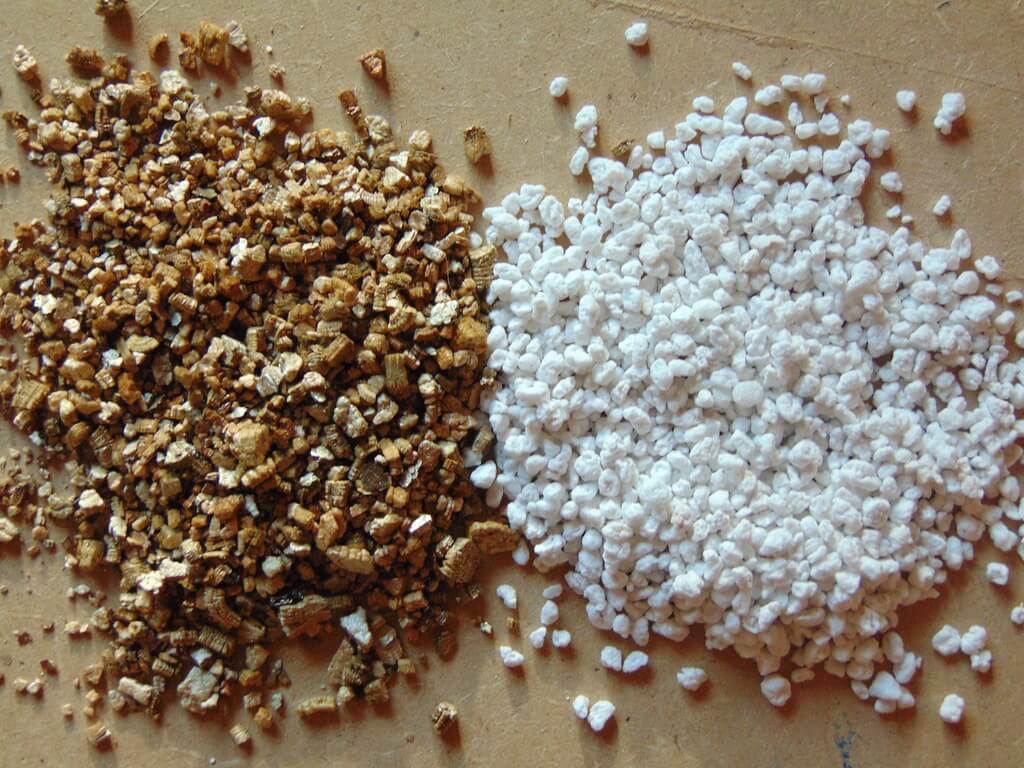
At a certain scale, making your own soil can also be much less expensive than commercial soil bags you purchase at the store. Herein we’ll teach you our techniques and methods that we use.
When you understand the components of a good garden mix, it can open a lot of doors for you. You will know how to improve practically any soil that you might be working with.
When Should You Consider Making Your Own Garden Soil?
The bottom line, whether you buy soil or make your own, neither is inexpensive. As it turns out, “cheaper than dirt” isn’t very cheap at all!
 The honest truth is if you only need a few cubic feet of soil, you are much better off just buying the soil you need. You will end up spending far more on the components to make your own soil than you would those few bags purchased from the garden store.
The honest truth is if you only need a few cubic feet of soil, you are much better off just buying the soil you need. You will end up spending far more on the components to make your own soil than you would those few bags purchased from the garden store.
If you need a lot of soil, either for a container garden or to fill a raised bed, that’s the point when making your own soil is worth both the time and the money. In these applications, you often need quite a bit of soil, which translates to a lot of bags of potting mix.
A general guideline you can use is if you would be spending more than $100 in potting mix bags, you probably should consider making your own. The materials to build your own soil, in sufficient bulk, will usually be similar at that point.
When you make your own soil, you get a lot more of it for the same amount of money.
What Characteristics Make For A Good Potting Soil?
This is probably a good starting point for the discussion. Dirt is not great for gardening and potting soil or garden mix is not necessarily “just dirt.”
There are some characteristics that you want to see in a good quality potting soil or garden mix. In general, a quality soil that will help your plants thrive has the following characteristics:
- Plenty of nutrients for your plants initial growth
- Drains water well / Non-clumping
- Retains moisture
- Healthy pH for plants
Good quality potting soil will compress together and hold its shape, without breaking apart. It should also crumble apart with only a small amount of effort applied.
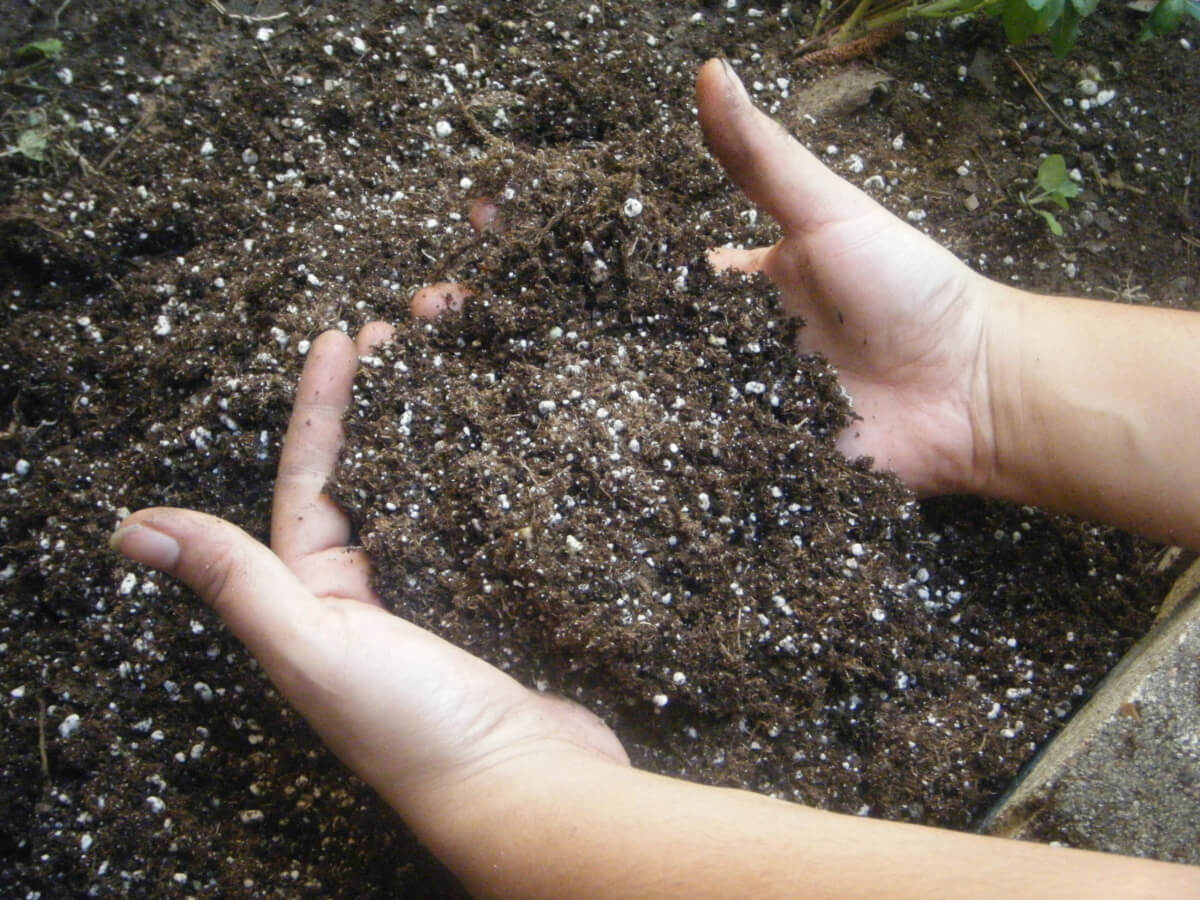
What you definitely don’t want to do is dig up a bunch of dirt from your yard and try to use that in your garden! Your average dirt will have none of the above characteristics and will offer you more troubles than it’s worth.
It’s important to point out that what is commonly known as “garden soil” is also not usually great for the purposes of growing plants. Garden soil can be used as an element in a soil mix, but it shouldn’t be used exclusively.
What Are The Major Components Of Potting Mix?
As mentioned above, you are looking for certain characteristics in your potting mix. We’ll go through these one by one and give some examples of materials that you can use to create those characteristics.
Nutrients
- Compost
- Worm castings
- Fertilizer
- Slow release fertilizers
- Azomite
- Greensand
Drains Water Well & Doesn’t Clump
- Sphagnum peat moss
- Coco coir
- Vermiculite
- Perlite
- Sand
- Composted wood chips
- Rice hulls
- Brewing grains (in limited quantity)
- Chopped straw
Moisture Retention
- Sphagnum peat moss
- Coco coir
- Vermiculite
- Greensand
- Compost
Soil Acidity or pH
- Garden lime
As you might have noticed, some materials provide multiple benefits. These are particularly good ingredients to use!
Don’t Worry Too Much About Soil pH!
We were hesitant to even mention pH, simply because that can turn a lot of people off from making their own soil. “It sounds complicated!”, they’ll say. We agree.
Here’s the thing. Plants are quite good at growing in soil that has a fairly wide pH. The image below shows various pH and the generally recognized ranges where a plant can take up those nutrients. Wide bars are good, narrow bars are bad.
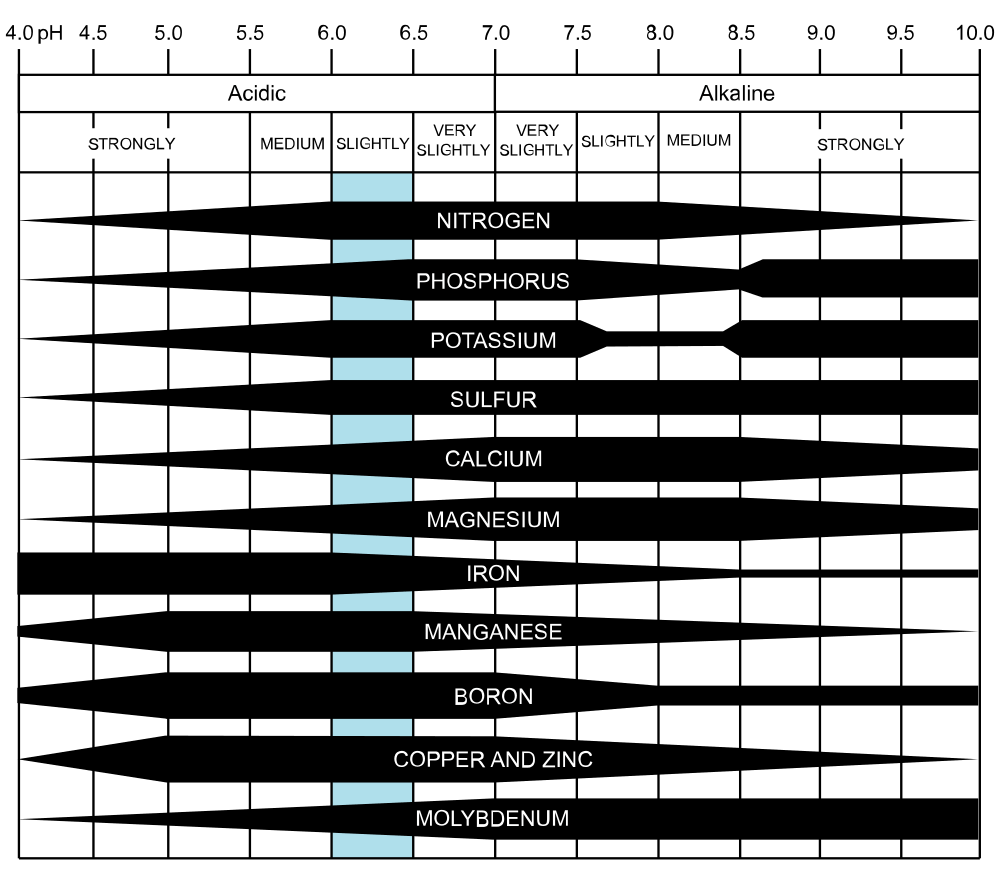
Will your plants grow a little bit better with the perfect pH? Sure. Will they also grow just fine if the pH is a little off? Yes they will. You have a pretty wide range to work in if you’re growing common garden vegetables.
With the ingredients we discuss here, the main one you have to worry about is sphagnum peat moss.
Peat moss has a lot of benefits. It will provide bulk, it breaks down slowly, it retains moisture and it promotes good soil drainage. But, peat moss is naturally acidic and will therefore tilt your DIY soil towards acidity.
If you use peat moss in your garden mix, it will be beneficial to correct that acidity by raising the pH of the soil!
If you want to correct the pH, you can do so by adding dolomitic lime, more commonly called garden lime. You can also find calcitic lime, which is basically the same thing with more calcium.
There are two types of these lime products out there, powdered form and granular form. Powered forms will tend to correct the pH more quickly, whereas granular variants will correct it more slowly. For that reason, granular variants are generally considered safer to use.
In general, consider adding the following amounts of garden lime to soil that uses peat moss:
- 1 Tbsp per gallon (4 liters) of soil mix, or
- 1 (heaping) cup per 15 gallons (60 liters) of soil mix, or
- 3 (heaping) cups per 50 gallons (200 liters) of soil mix
Other than that, you don’t really have to worry about pH. In many cases, you could probably even skip this step and still be just fine! Again, this is about trying to get optimal pH and not about just getting plants to grow.
Remember, There Is No Perfect Recipe
There are many ways to go about formulating your own potting mix and garden soil.
There isn’t just one perfect recipe.
 Whenever possible, we would encourage you to work with ingredients that you have access to!
Whenever possible, we would encourage you to work with ingredients that you have access to!
What do we mean by this?
If you have access to cheap compost, that should be a primary ingredient. If you have access to free sand or composted wood chips, use that! Have a local peat moss seller, use them!
If you can’t find one particular ingredient, use something else that provides the same benefit. If you have more of something, use more of it!
There is a lot of room for experimentation in making your own soil. That’s certainly one of the main benefits of DIY potting soil. You can make it with what you want and to have the characteristics you want.
Example DIY Garden Soil Mix Recipes
Here are a few of the garden soil recipes that we know about and have also used. We use the “part system” so you can decide what quantity you want to make. That way, you can base it on gallons, liters, buckets, bushels, or dump trucks for quantities.
As you will see, there are a lot of different ways to go about making various soil mixes! Also, for all recipes, coco coir can always be substituted for peat moss if desired.
Mel’s Mix from Square Foot Gardening
- 1 part compost (from 5 different sources)
- 1 part vermiculite
- 1 part peat moss or coco coir
- Garden lime, if using peat moss (~1Tbsp per gallon of mix)
Frosty Garden’s “Secret Weapon” Potting Soil:
- 2 parts compost (typically homegrown, sometimes commercial)
- 1 part peat moss (locally sourced when possible)
- 1/2 part vermiculite
- 1/2 part perlite
- Greensand per manufacturer recommendation
- Biolive per manufacturer recommendation
- Azomite per manufacturer recommendation
- Garden lime, if using peat moss (~1Tbsp per gallon of mix)
General Potting Soil
- 1 part peat moss or coco coir
- 1 part compost
- 1/2 part perlite
- Fertilizer per manufacturer recommendation
- Garden lime, if using peat moss (~1Tbsp per gallon of mix)
DIY Potting Soil
- 2 parts peat moss or coco coir
- 2 parts vermiculite
- 1 part compost
- Fertilizer per manufacturer recommendation
- Garden lime, if using peat moss (~1Tbsp per gallon of mix)
Homestead Potting Soil
- 2 parts peat moss or coco coir
- 1 part compost
- 1/2 part vermiculite
- 1/2 part worm castings
- Fertilizer per manufacturer recommendation
- Garden lime, if using peat moss (~1Tbsp per gallon of mix)
Garden Soil Based Potting Mix
- 1 part peat moss or coco coir
- 1 part garden soil
- 1 part compost
- 3/4 part perlite
- Fertilizer per manufacturer recommendation
- Garden lime, if using peat moss (~1Tbsp per gallon of mix)
Houseplant Mix
- 2 parts peat moss or coco coir
- 1 part perlite
- 1/16 part sand (approximately 3/4 cup per gallon of mix)
- Fertilizer per manufacturer recommendation
- Garden lime, if using peat moss (~1Tbsp per gallon of mix)
Cactus Mix
- 3 parts peat moss or coco coir
- 2 parts sand
- 1 part perlite
- 1 part vermiculite
- Fertilizer per manufacturer recommendation
- Garden lime, if using peat moss (~1Tbsp per gallon of mix)
Example Seedling Mix Recipes
If you’re looking to build your own seedling mixes, there’s a number of different approaches that you can use. All of these will work for germination and raising baby seedlings.
One important thing to observe is that these are all “low nutrition” soil mixes. They are not designed for long term plant growth. Rather, they are best used for initial germination with a plan to transplant your seedlings to more substantial soil once they are established.
You’ll likely see a lot of similarity between the recipes. The differences are mostly about the drainage performance of the soil, which is highly beneficial for germination purposes.
When we build seedling mixes, we strongly prefer using coco coir over peat moss. The reason for this is that its slightly less biologically active.
We have some additional notes on the sterility of seedling mixes below. This is a difficult process to perform in a DIY fashion, so sometimes commercial mixes are beneficial to buy.
High Drainage Seedling Mix
- 2 parts coco coir
- 2 parts vermiculite
- 1 part sand
Premium Drainage Seedling Mix
- 2 parts coco coir
- 1 part vermiculite
- 1 part perlite (fine, if possible)
- This is our generally preferred seedling mix!
Low Adjunct Seedling Mix
- 7 parts coco coir
- 1 part vermiculite
- 1 part perlite
Super Basic Seedling Mix:
- 1 part coco coir
- 1 part vermiculite
Seedling Mix
- 2 parts coco coir
- 2 parts vermiculite
- 1 part perlite (fine, if possible)
Techniques For Mixing Up Your Garden Soil
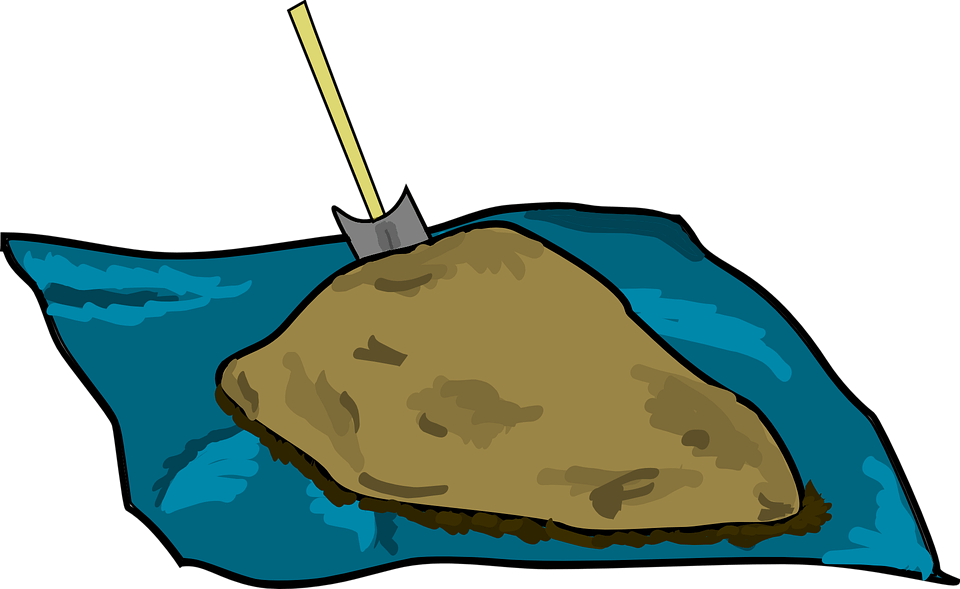 If you want to make just a few gallons of soil at a time, we have found using a wheelbarrow to mix the ingredients as a good method.
If you want to make just a few gallons of soil at a time, we have found using a wheelbarrow to mix the ingredients as a good method.
This is obviously a bit limited as you can only mix an amount that will fit in your wheelbarrow.
If you want to make up larger amounts, we recommend laying out your ingredients on a tarp. You can mix up the ingredients by hand and also use the edges of the tarp to help mix your materials together.
We have used the tarp technique to mix up to about 50 gallons of mix at a time and it works great. Yes, you get dirty. Yes, it’s kind of hard. This is what gardening is about.

If we had access to a concrete mixer, we would strongly consider using it to help make up soil. That would make some short work of soil building!
What About Making Your Own Seedling Mix?
One of the most important characteristics of seedling mix is that it’s sterile. That means that it’s completely devoid of life. We are also speaking in terms of microbiology, nothing is alive.
Sterile can be difficult for the home gardener to achieve. It can be done in the home, but it requires certain treatments.
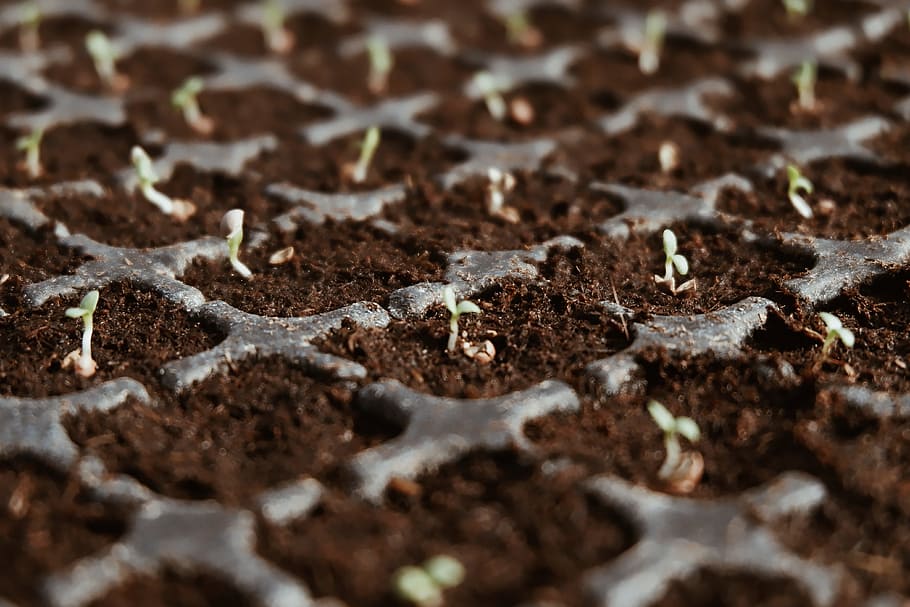
In general, we would advise most gardeners to purchase seedling mix instead of making their own. Almost all commercially available seedling mixes are sterilized.
The seedling mix recipe we provided above is relatively sterile, but it’s not guaranteed. It deals with some organic materials, like sand, which can introduce bad things into your seedling mix. It’s impossible to avoid everything in terms of microbiology.
Seedling mix is not often needed in extremely high quantities, either. Only a CSA farm, or other major food producer, would have the demand needed to make your own seedling mix make sense.
We buy our seedling mix, despite having every one of the needed ingredients on hand. We go through a large bag every two years, so it’s not worth our time to make it.
If you want to sterilize your soil, steam is the best technique to use. What we recommend is heating your soil with steam to about 140-160 degrees Fahrenheit and holding that temperature for at least 15 minutes.
There are other techniques out there, but this is the safest method that will ensure good results. If you’re reading about putting soil in your oven or microwave, do yourself a favor and don’t do it.
Compost Is A Phenomenal Soil Ingredient
One thing you’ll probably recognize is that compost is a pretty common ingredient in practically every soil mix.
Compost provides long term nutritional support for plants. Unlike a lot of fertilizers, compost requires complex microbiological processes to occur in order for the nutrients to be available to the plant.
We make our own compost here at Frosty Garden. It’s a great technique that gives us the ability to process our waste into a highly usable ingredient. The best thing about it? It’s practically free to create. It also saves us time and money by not having to throw away organic materials.
If you want to incorporate DIY compost into your soil, it’s definitely wise to be careful how much seed you get in your compost. I’m not talking about tomato seeds – I’m talking weeds. If you’re composting dandelions and other weeds, it might be best to favor commercial compost for making your soil.
There are ways you can reduce your weed exposure, usually by sterilizing your compost or soil. If you don’t mind picking weeds out of your beds or containers, there is little to be concerned about.
Should You Build High Quality Potting Soil For Raised Beds?
We think this is a good question and the answer is that it’s entirely up to you. It can be quite costly to purchase all the supporting materials to fill such a volume.
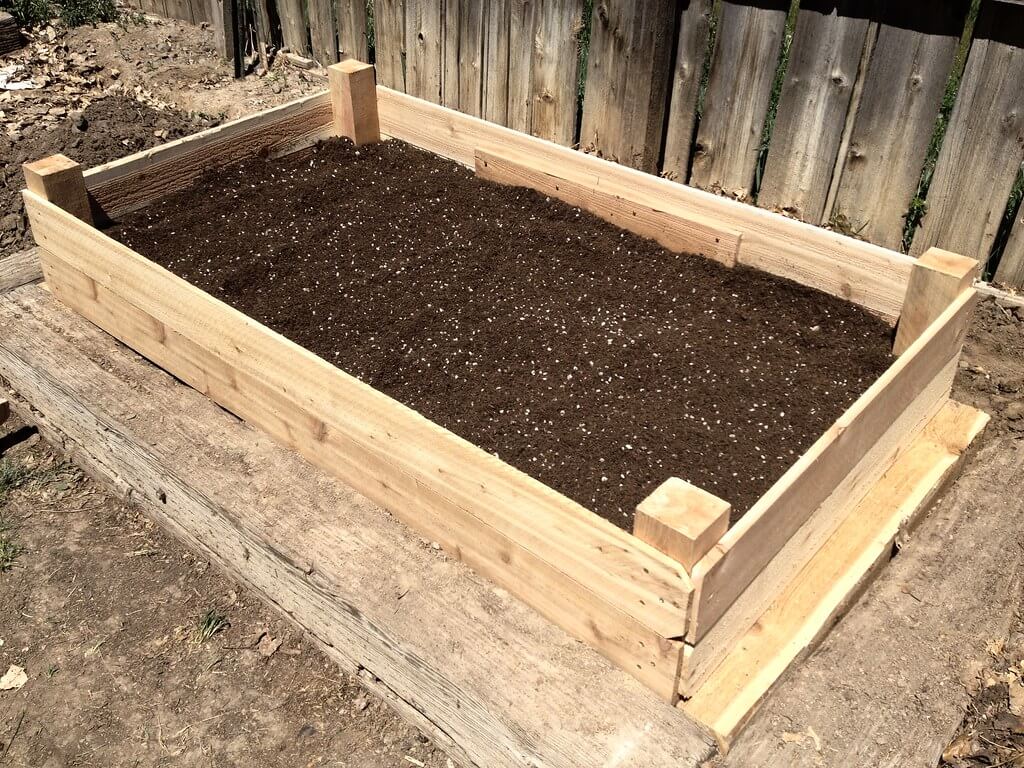 We made our own soil for our beds (using our “Frosty Garden secret weapon” described above) and can tell you that we spent hundreds of dollars on the soil for our beds.
We made our own soil for our beds (using our “Frosty Garden secret weapon” described above) and can tell you that we spent hundreds of dollars on the soil for our beds.
We looked at our soil as a long term investment and wanted our beds to produce intensively for years to come. Our raised beds produce every kind of fruit or vegetable incredibly well, so it was worth it for us.
What we can tell you is that we’ve seen people experience a lot of troubles with trying to fill beds inexpensively. Almost everyone that does it “cheap” has regrets afterwards.
Working With Inexpensive Bulk Garden Soil
Several vendors around interior Alaska sell what they call “garden soil” and the quality of that soil vastly varies.
Some is just dirt they dug out of the ground, others do make some effort to combine dirt and peat moss to make a very simple garden mix.
Even in the best case scenario, we’re still missing critical components from our soil.
In every one of these cases, the garden soil product can be greatly improved.
What we’d encourage you to do is consider the concepts that we discuss in this post that make for good garden mixes. That garden soil can certainly be a quality component of your total garden bed!
It is a little bit difficult to give exact guidance on what to do with this type of bulk soil, mostly because it varies based on the vendor and batch. It would be wise to mix some small batches (using the part system) to try and get a good consistency, at least before making the bulk of your soil.
It would be best to combine other ingredients to make a really nice, quality garden bed soil. If we were going this route, this is the starting point I would use:
Bulk Garden Bed Mix
- 2 parts garden soil
- 1 part compost
- 1 part peat moss (or coco coir)
- 1 part perlite
- 1/8 to 1/4 part sand
If I had a little bit more budget and we were looking to improve the above recipe even further? I would do something like this:
Improved Bulk Garden Bed Mix
- 2 parts garden soil
- 2 parts compost
- 1-2 parts peat moss (or coco coir)
- 1 part perlite (and possibly 1 part of vermiculite, or 1/2 & 1/2)
- 1/8 to 1/4 part sand
The minor changes in the above recipe would greatly improve water retention and shedding. It would also improve the nutrient value of the soil significantly. Both of those items would be worth the additional cost.
How Much Soil Do You Need To Make?
Warning: MATH! If you don’t need to learn how to make complex soil quantity calculations, feel free to skip this section.
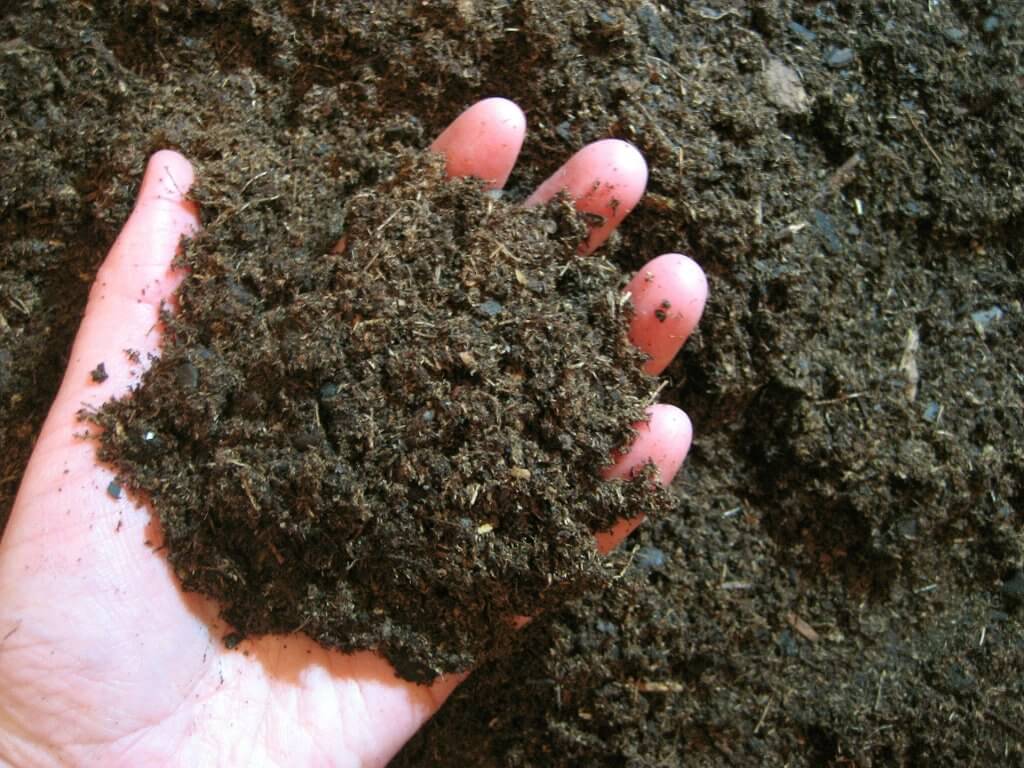 It’s usually a good idea to figure out how much soil you will actually need. This will help you when planning out how much material to purchase for your project.
It’s usually a good idea to figure out how much soil you will actually need. This will help you when planning out how much material to purchase for your project.
In our experience, figuring things out by the cubic foot has been the most accurate method that we’ve found. (You can do this in metric, too, but the math will be slightly different.)
Most of the products you might purchase are sold by the cubic foot, also making this very easy.
Here are some reference numbers that you might find helpful:
- 1 gallon container: 0.13 cubic feet
- 5 gallon bucket: 0.69 cubic feet
- 10 gallon grow bag: 1.3 cubic feet
- Raised bed: Length (ft) x width (ft) x (height (in) / 12)
As we know, we need different quantities of different materials. You can fairly easily determine how much of each material that you need.
For our example, we’ll assume you are filling a 4 foot x 10 foot x 1 foot raised bed and you’re using “Frosty Garden’s Secret Weapon” soil mix.
First, figure out how many cubic feet of total soil mix you would need:
- 4 foot x 10 foot x (12 inch / 12) = 40 cubic feet
Then, determine the recipe’s total number of parts:
- 2 parts compost + 1 part peat moss + 1/2 part vermiculite + 1/2 part perlite
- Simple addition gets us to 4 total parts in the recipe
For each material, divide the total cubic foot volume needed by the total number of parts in the recipe, and then multiply by the parts needed of each material:
- Compost: (40 cubic feet / 4 parts) x 2 parts compost = 20 cubic feet
- Peat Moss: (40 cubic feet / 4 parts) x 1 part peat moss = 10 cubic feet
- Vermiculite: (40 cubic feet / 4 parts) x .5 part vermiculite = 5 cubic feet
- Perlite: (40 cubic feet / 4 parts) x .5 part perlite = 5 cubic feet
- Total: 40 cubic feet!
In the event you are ordering materials by the cubic yard, you can figure that out too! Simply divide the total cubic feet needed by 27 to get the number of cubic yards.
Go Forth And Make Your Own Garden Mix!
We hope that this topic has been insightful. Making our own soil has been a rewarding effort. It’s one of those things that actually has helped us save a ton of money.
If you are looking to build out a garden bed or start a good sized container garden, making your own soil is a great way to get more bang for your buck.
If you have any questions or if we missed something, feel free to slap a comment below!
That’s All We Wrote!

Having a good time? We have an ever growing list of insightful and helpful subarctic & cold climate gardening articles, waiting out there for you!
- Cold Climate Gardening Basics 👉
- Growing Your Garden From Seed Indoors 👉
- Advanced Cold Climate Gardening Techniques 👉
- Plant Specific Cold Climate Growing Guides 👉
- Subarctic Perennial Food Forests & Foraging 👉
- Indoor Garden Lighting & Grow Rooms 👉
- Greenhouses & Temperature Control 👉
- Harvesting & Food Preservation 👉
- Solving Cold Climate Garden Problems 👉
- 1 Minute Reads On Tons Of Garden Topics 👉
FrostyGarden.com is 100% ad-free and we do not use affiliate links! This resource is voluntarily supported by our readers. (Like YOU!) If we provided you value, would you consider supporting us?

Wow, this was an awesome article! Thank you! Where are you sourcing your peat moss? Are you going to one of the gravel pits like great northwest to get a truck load of peat? Are you you going into the woods around fairbanks and harvesting sphagnum moss? and if so, how do you “treat” the sphagnum poss? I too am a community garden grower at the same place. Have we met? I’ve been gardening there for 20 something years. : )
Thanks for the kind comment! In years past, you could get inexpensive peat moss from the soil seller behind Brown Jug. I heard there were some difficulties with that seller starting last year, but don’t have personal experience. Lately, we’ve needed less peat moss, so we’ve purchased large bricks at either Home Depot or Risse’s Greenhouse. Great Northwest may also be able to source peat moss, but I haven’t checked. (BTW, their garden mix is probably the best in town, but note what we say about “garden soil” in this post…it has decent amounts of peat moss in it, but still can use further amendment to make it great.)
And we probably have met. We’re over in F2 & F3. I think I know who you are. 🙂
One last comment: can you provide suggestions for where I might source these soil ingredients locally? and seed starter mix? Folks have recommended the Pro mix but I’ve forgotten if I’m supposed to get the pro mix bmx type of seedling starting mix or just the plain one. Any suggestions? Also, I believe Terry R. master gardener suggested that some seeds be planted directly in the growing medium (as opposed to seedling start mix) that would get transplanted outside and not moved into growing medium as a seedling (I think this was to prevent disturbing their roots).
thanks!
Figured I’d respond separately. We buy most of our stuff from Risse’s Greenhouse. Compost has been a challenge lately, though, since the Golden Heart Utilities shut down their production in 2019. (We’ve had to seriously beef up our compost production heavily to deal with it.) You can often find bags of compost (typically steer manure) at Home Depot and Lowes early in the season. Another source is finding local animal farmers, they often are looking for people to take their manure. You still have to compost it a bit before using it, as it’s typically too “hot” coming straight from the farm.
For seed mix, we often have only found that at Holm Town. In a lot of cases, a good soil (such as ProMix) can actually be used for seed starting, but you will often get moss growing since it’s not sterile. We typically go from seeding tray (with seed mix) to transplant pot (regular potting soil) fairly quickly. There are very few plants that are highly sensitive to transplants (spinach & corn come to mind), but even these will transplant with fairly high success.
Sorry but your math while sound, is going over my head. Can you please just tell me exactly what I need to make 1 cubic yard of potting soil?
I can appreciate that! One cubic yard is exactly 27 cubic feet. Put another way, you basically need (40) 5 gallon buckets full of material total to compose one cubic yard. The exact ratios would depend on your desired materials, as mentioned in the post. It can be a little challenging to figure out, but remember, it’s not a perfect science and there’s a lot of flexibility.
I’m liking what you’re doing. Your site is so full of good information. Do you reuse your potting soil from year to year?
Thanks for the kind comment! We do re-use our potting soil from year to year, some of it for more than six years now. We do observe significant depletion of nutrition in subsequent years. We correct this by adding additional compost and by using fertilizer to re-enhance the soil. This topic is actually on-deck for a post here this winter as we feel it’s important to cover for a sustainable container garden!
Can chicken manure or is it to hot
Chicken manure would still be too hot to add directly to soil. You can compost it, though, and it’ll make an excellent addition to your soil. You can often compost your bedding along with the manure, aim for about 75% bedding with 25% manure (roughly) for best results. (Assuming you use straw or wood shavings for bedding, of course.) It’ll only need about 4-6 weeks to compost down that way!